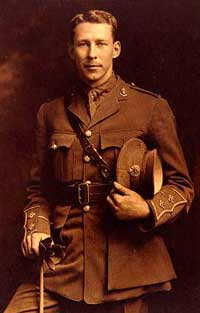Additions will be checked before being published on the website and where possible will be forwarded to the person who submitted the original entries. Your contact details will not be forwarded, but they can send a reply via this messaging system.
please scroll down to send a message
Capt. Coulson Norman Mitchell VC.
Canadian Army 1st Canadian Tunnelling Coy.
from:Winipeg, Manitoba, Canada
Norman Mitchell was born in Winnipeg on 11th of December 1889. He graduated from the University of Manitoba with a degree in Engineering in 1912 and was then employed as a construction engineer with the Foundation Company of Canada.
He enlisted with the Canadian Engineers on the 10th of November 1914 as a Sapper and was posted to 4th Field Company. In December, he joined the 2nd Division Signal Company and was transferred to the Canadian Overseas Railway Construction Corps in May 1915. He sailed for England in June 1915 and underwent training at Longmoor Barracks. In August, he proceeded to France and then to Alveringham in North Belgium. He returned to England in October 1915. In November 1915, he was promoted to Sergeant. He received his commission as Lieutenant in April 1916. In May, he was posted to 1st Canadian Tunnelling Company returned to France. Sjt Mitchell was in charge of the "Bluff" shaft and remained in the area until the end of 1916, for this work he was awarded the Military Cross. He was promoted to Acting Captain in September 1917 and substantive on 24 May 1918.
By October 1918 the British 3rd Army, including the Canadian Corps, had reached a line south west of Cambrai. The plan of attack had the Canadian Corps on the left flank, faced with the wide Canal de l'Escout. The preliminary attack was to be made by the Canadians at night and by all forces by day. The point of attack was over the bridge, Pont d'Aire, leading to the village Escoudoeuvers on the N.W. of Cambrai. This was complicated by the fact that along with the main bridge there were two mill streams that had to be crossed. Successful completion of the plan required that demolition of these bridges be prevented and that in the event of their being destroyed, a bridging train following the leading party would erect platoon bridges
As a result of a warning order, Capt. Mitchell was tasked to go forward with the infantry and a small party of engineers, to take the existing bridges before they were demolished. Mitchell with his party, a sergeant and five sappers, went forward and joined "A" Company, 26th Battalion. The small party of Sappers went forward to the first bridge to find that it had been demolished and runners were sent back to the bridging train with the news. On reaching the second bridge, it was found that it had been mined, again information as sent back. With only four remaining in the party, the third and main bridge was reached. The main bridge was about 15 feet above the water level and had a tow-path on each side passing under it. Feeling along the handrails, they found several stick grenade handles with fuses leading down below the deck. The important thing was to find the electrical leads, which would permit the firing of the demolitions. Captain Mitchell posted a sentry at both ends while he and his sergeant slid down the bank and found large boxes of explosives. The scaffold and ladders still in place enabled them to tackle the charges quickly. They were cutting the electrical leads and began on the fuses, when the sentry on the enemy side raised the alarm. Shots were fired and a number of the bridge demolition party accounted for. A covering party of infantry was sent to take over the German prisoners and provide a covering party. Captain Mitchell and his Sappers then removed several hundred pounds of charges.
As a result of his actions on the 8th and 9th of October 1918, he was awarded the Victoria Cross. Investiture took place at Buckingham Palace on the 3rd of April 1919. His sergeant and other Sappers were awarded the Distinguished Conduct Medal with one sapper being awarded the Military Medal.
In April 1919, Capt Mitchell returned to England and served with the C.E. Regimental Depot until demobilization, when he returned to Canada.
He returned to the Foundation Company of Canada then in 1926 joined the Power Company in. During the Second World War Mitchell again served with the Engineers, reaching the rank of Lieutenant-Colonel. He retired from the military on the 24th of September 1946 and returned to the Power Corporation in Mount Royal, Quebec, retiring in 1957.
Lieutenant-Colonel Mitchell, VC, died in Mount Royal on 17th November 1978, and is buried in the Field of Honour, Pointe Claire, Quebec. His medals and other memorabilia are on display at the Canadian Military Engineers Museum.
